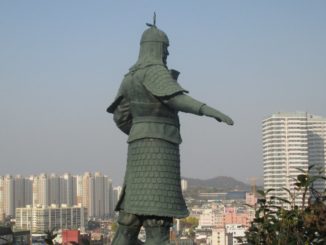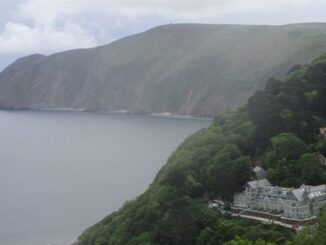
Ramblersen2, CC BY-SA 4.0, via Wikimedia Commons
Transatlantic slavery was ended in 1833 by Britain after a campaign by William Wilberforce. It is one of the key dates in British history, and Wilberforce is a name known to everyone. Britain may have been the architect of one of the great evils of history, but it was also the antidote. We did at least do the right thing in the end. Every British schoolboy went out into the world believing that.
The truth is a bit less clear-cut. Though Britain’s action was internationally decisive, we were not, in point of fact, the first nation to withdraw from the Transatlantic slave trade. If you are struggling to think which country was, that’s probably because you had never thought of it as a colonial power.
Step forward Denmark.
The Scandinavians have successfully sold the world the story that they, unlike nearly all other European powers, have been a benign and progressive force in the world since the Viking age ended. In fact, Sweden was for a time a European great power, colonizing Finland and Estonia. Denmark had Caribbean colonies, Saint Thomas, Saint John, and Saint Croix. Territorially, they were dots on the map. But Denmark’s role in the slave trade was rather more significant. And because Norway was fully integrated into Denmark throughout this period, it too is implicated.
Here is a translated and abridged article showing how the Danes themselves view this stain on their history, and outlining the course of their involvement in it. It is by Erik Gøbel of danmarkshistorien.dk of Aarhus Universitet (whose website purports to be bilingual; all I could get was the Danish version):
Den danske slavehandel, ca. 1660-1848
“Denmark participated in the slave trade from the 1660s to the early 1800s. It transported about 111,000 Africans across the Atlantic, under inhuman conditions. In 1792, Denmark became the first slave-trading nation to ban the trade, with effect from 1803. However, it continued internally on the three Danish-West Indies islands until 1848.
Europeans transported about 12½ million African slaves across the Atlantic between 1525 and 1866. The 111,000 shipped in 430 ships under the Danish flag, between the 1660s and the early 19th century, was about 2.3 percent of the entire slave trade to the Caribbean in the period of Denmark’s involvement.
The Danish slavers usually plied the infamous triangular route, in this case from Denmark to the Gold Coast, from there over the Atlantic with slave cargos to the Caribbean—the Middle Passage—and then home with raw sugar to Denmark. In the 1790s, merchants and shipowners in the Danish West Indies started sending ships directly to Africa to get slaves.
Triangular journeys usually lasted for a total of 1½ years, of which the transfer from Africa to the Caribbean with the human cargo took 2-3 months. The conditions on board the crammed ships were horrific. On average, 16-20 percent of the slaves died from diseases such as malaria, yellow fever and dysentery, which ran rampant among the physically stressed, poorly-fed and dehydrated Africans.
In addition, on arrival in the West Indies the slaves were so weakened that many died during their first year on the islands. This happened despite the best efforts of the doctors on the ships and on the plantations to keep as many of the expensive slaves alive as possible.
When a cargo of slaves was on board, and the ship departed the African coast, rebellions sometimes broke out. They were crushed ruthlessly, and human life was inevitably lost.
In 1709, on the “Fredericus Quartus”, some of the 435 slaves got free from their chains and rebelled. After a tough struggle, the rebellion was defeated. The next morning the slaves were called on deck, and the boatman chopped the right hand of the rebel leader and displayed it to terrorize and warn the others. Then he chopped off his left hand and his head, and the body was raised in the ship’s rigging, where it hung the following days. The other participants in the rebellion were whipped and had pepper and salt rubbed into the wounds.
On the Gold Coast, slaves were bought by barter. In many cases, the captain turned his cabin into a veritable showroom, with sellers boarding and taking samples. The most sought after items were coloured East Indian cotton and other textiles. There was good demand for firearms, herbs and brandy, in addition to small items like mirrors, corals, hats and tobacco pipes. Most slaves were boarded at Fort Christiansborg or the other Danish trading stations on the Gold Coast. But when slaves were in short supply, Danish ships had to trade in other nations’ places to get a full cargo. After arriving in the Caribbean, the Africans were sold at auction to slave owners.
The inhumane conditions of the slave ships and in the West Indies, where mortality in the slave population was always higher than the birth rate, prompted [German-born slave owner and] Danish Finance Minister Ernst Heinrich von Schimmelmann (1747-1831) to work for the abolition of the slave trade. The fruit of his campaign was the Royal Decree of 16 March 1792 banning the transatlantic slave trade under the Danish flag.
However, the ban was not meant come into force until 1803. During the intervening decade, the import of new slaves to the Danish West Indies was financially supported by the state. The purpose was to build a large and gender-balanced slave population that could reproduce itself, so that it was no longer necessary to pick up new slaves in Africa. Paradoxically, the result was that in this transition period from 1793 to 1802, the Danes picked up more slaves in Africa than ever before or after. There were a total of 24,900 slaves on 125 journeys, corresponding to a ship of 200 new slaves each month.”
Denmark has never apologised for its role in the transatlantic slave trade, though the question has been much debated. In the Politiken newspaper of August 10, 2005, the Director of the Danish Center for Human Rights stated that “The slave trade of the past does not feature enough in Danes’ self-perception” and that “The Danes should apologize for slavery.” But in 1998, then Foreign Minister Niels Helveg Petersen, among others, argued against. “I do not think it right that people who had nothing to do with slavery should apologize to people who were not subjected to slavery,” he said.
The three islands were sold to the US in World War 1, and became the US Virgin Islands.
Quotation from this slightly adapted translation is at user’s own risk. I take no responsibility for errors of translation.
© Joe Slater 2017 2024
For more on Scandinavia, please see my free book, Kebabville, which can be downloaded here.



